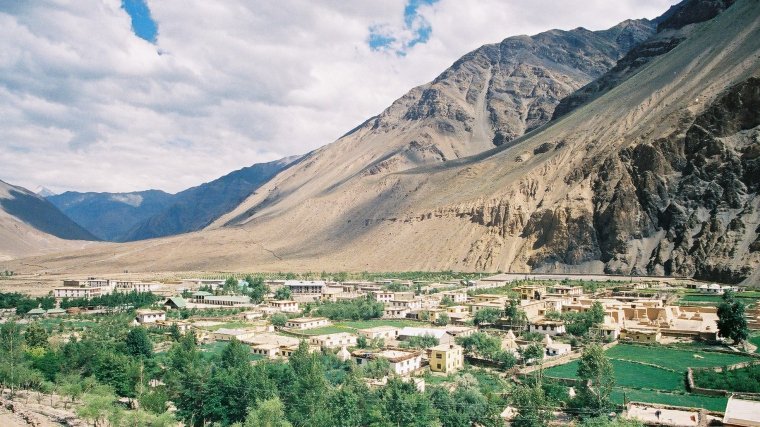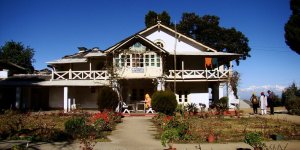| Travel / Ashram, Monasteries |
Tabo Monastery, Himachal Pradesh, India
Nyingma, Gelug Tradition, 10th century, about 60 monks.
Tabo Monastery (Tabo 'Chos-hKhor' or Doctrinal Enclave) also known as the "Ajanta of the Himalayas" was founded in 996 CE in the Tibetan year of the Fire Ape by the Tibetan Buddhist lotsawa (translator) Rinchen Zangpo (Mahauru Ramabhadra)1, on behalf of the king of western Himalayan Kingdom of Guge, Yeshe-Ö.
Tabo is the oldest continuously operating Buddhist enclave in both India and the Himalayas and is protected by the Archaeological Survey of India (ASI) as a national historic treasure.
On the sheer cliff face above the monastic enclave are a series of caves which were used as dwelling units by the monks. Dim traces of the paintings that once adorned the rock face are still visible, hence the name "Ajanta of the Himalayas". ASI had proposed this monastery for recognition as a UNESCO World Heritage Site.

Tabo village as viewed from the caves. Monastery stupas are visible on the right. Photo: Amit Parikh, Wikipedia.
Location
The monastery is situated in the Spiti Valley, Himachal Pradesh, an isolated valley with a total population of 10,000, above Tabo village. While Tabo village is in a bowl-shaped flat valley, the monastery is also in the bottom of the valley, unlike other monasteries, which are perched on hills; in the past the region was part of Tibet.
The area it is very arid, cold, and rocky at an altitude of 3,050 meters.
Above the monastery there are several caves carved into the cliff face and used by monks for meditation. There is also an assembly hall in the caves and some faded paintings on the rock face.
History
The monastery was built by the Buddhist king (also known as Royal Lama) Yeshe-Ö in 996 A.D. It was renovated 46 years later by the royal priest Jangchub O'd, the grandnephew of Yeshe-Ö. They were kings of the Purang-Guge kingdom whose ancestry is traced to the ancient Tibetan monarchy and extended their kingdom from Ladakh to Mustang by building a large network of trade routes and temples along the route.
Tabo was built as a 'daughter' monastery of the Tholing Monastery in Ngari, western Tibet. This royal dynasty was instrumental in re-introducing the Indian Mahayana Buddhism in Tibet, the second major spreading of Buddhism in Tibetan history.
They contributed significantly to the political, religious, and economic institutions of Tibet in the 11th century through the building of Tabo Monastery; this is documented in the writing on the walls of Tabo.
The iconographic depictions are reported to be of 1042 and later, consisting of paintings, sculptures, inscriptions, and extensive wall texts. The translator Rinchen Zangpo, a Tibetan lama from western Tibet, who was chiefly responsible for translating Sanskrit Buddhist texts into Tibetan, was the preceptor to King Yeshe-Ö who helped in the missionary activities. Several Indian pundits visited Tabo to learn the Tibetan language.
During 17th to 19th centuries, the monastery and the bridge across the Spiti River witnessed historical events and political turmoil in the area. Manuscripts such as Tabo Kanjur make mention of some violent confrontations.
An inscription of 1837 records attacks on the Tabo Assembly Hall in 1837, which can also visually be seen by damages to some parts of the walls. The attack is attributed to 'Rinjeet's troops' who were under the kings of Ladakh.
With the British Rule from 1846, the area enjoyed peace until the 1950s when the Indo-China border disputes reawakened the political claims of the border posts. In 1855, Tabo had 32 monks.
The original monastery was severely damaged in the 1975 Kinnaur earthquake. After its full restoration and the addition of new structures, the 14th Dalai Lama visited the monastery and initiated the Kalachakra Festival in 1983. He also revisited in 1996 when the millennium of the monastery’s existence was celebrated and has returned on numerous occasions.
In 2009, the Dalai Lama was scheduled to inaugurate the Kalachakra Stupa, which has been built as an auspicious symbol, following the special blessings of Kalachakra he had performed earlier. Sakya Trizin and other Tibetan teachers and meditation masters have also visited the monastery and encouraged the Buddhist practice among the local people.
Features
The monastery is known as "the Ajanta of the Himalayas" because of its frescoes and stucco paintings. The iconography of this period in the temples also supports the bond that existed between the two cultures of India and Tibet.
There is a large and priceless collection of thankas (scroll paintings), manuscripts, well-preserved statues, frescos, and extensive murals which cover almost every wall.
While in the earlier period, paintings in the interior of the main Tabo temple and its stupas represented the Nyingmapa, Kadampa and Sakyapa traditions, the later period represent paintings of the Gelugpa tradition.
Tabo Monastery has nine temples, four decorated stupas, and cave shrines. The paintings date to the 10th-11th centuries for main temple (Tsug la Khang), 13th-14th centuries for the stupas, and from the 15th to the 20th centuries for all the other temples. Yeshe-Ö and his two sons when they built the monastery in 996CE blended the provincial and regional characteristics with that of India and Central Asia.
One feature mentioned in this regard is the iconographic theme of non-Buddhist traditions emanating from the protectress deity Wi-nyu-myin.
The main temple is considered to represent the entire Vajradhatu Mandala.The monastery has a large collection of manuscripts and Pramana texts, which were filmed between 1991 and 1998.
The nine temples:
• The Temple of the Enlightened Gods (gTug-Lha-khang), also known as the assembly hall (dukhang) is the core of the complex. The central figure of this temple is Vairocana, the main deity of Vajradhatu. represented on a lotus throne, turning the wheel of law. Along the walls are life sized stucco images of the Vajradhatu Mandala. Thirty-three in all these are other deities of the pantheon, for example Vajrasattva.
• The Golden Temple (gSer-khang) is said to have been once covered with gold. It was renovated by Sengge Namgyal, a king of Ladakh in the 16th century. The walls and ceilings are covered with magnificent murals, which are well preserved and are dated to the 16th century. The other iconographic figures seen here are also found in other temples within the complex, and one such is of Vajradhara depiction.
• The Mystic Mandala Temple / Initiation Temple (dKyil-kHor- khang) has a large painting of Vairocana who is surrounded by eight Bodhisattvas. The other walls are covered in mandalas. This is where monks receive their initiations.
• The Bodhisattva Maitreya Temple (Byams-Pa Chen-po Lha-khang) is an ancient temple built in the first 100 years of the main monastery. The image of the Bodhisattva Maitreya here is over six metres high. There are also murals showing Tashilhunpo Monastery in Shigatse and the Potala in Lhasa. A carved stone column base has the figure of a lion.
• The Temple of Dromton (Brom-ston Lha khang) is thought to have been founded by Dromton (1008-1064 CE), one of the main disciples of Atisha. The Large Trom-ton Temple has murals of the eight Medicine Buddhas, which are dated to the 17th century; at the base of this temple the life of Shakyamuni Buddha is painted in a narrative form.
The Small Mandala Temple is used for tantric rituals and teachings, may also be of the early period.
The interior of the Small Trom-ton Temple has very elegant paintings; however, remnants of carvings, dates attributed to the 13th or 14th century, are discerned at the entry door to the temple. The Nun's Temple, a small temple, is seen on the back wall of the compound; the paintings here dated to 18th century are not of good quality.

Mural inside Tabo Monastery. Photo: Sumita Roy Dutta. Wikipedia.The above are accepted as the earliest temples of the Tabo complex and the following are later additions.
• The Chamber of Picture Treasures (Z'al-ma) is a room attached to the Enlightened Gods temple. It is covered with beautiful paintings of the Tibetan style.
• The Large Temple of Dromton (Brom-ston Lha khang) is the second largest temple in the complex. The front wall has the figure of Sakyamuni flanked by Sariputra and Maha Maugdalayana. The outer walls depict the eight Medicine Buddhas and Guardian Kings.
• The Mahakala Vajra Bhairava Temple (Gon-khang) contains the protective deity of the Gelukpa sect; it contains fierce deities and is only entered after protective meditation. At times it is called the “temple of horror.” The Protectress deity of the monastery along with her retinue are depicted on a large panel on the east wall of the main entrance.
• The White Temple (dKar-abyum Lha-Khang), also called the Nuns’ Temple, is a small building at the back of the old temple site and has some paintings dating back to the 18th century.
Monastic Life
The monastery has 60 resident monks. Kyabje Serkong Tsenshap Rinpoche (1914-1983) served as the Head Lama prior to Geshe Sonam Wangdui, who was appointed the Abbot of Tabo Monastery in 1975. He held this position until he died on 11 August 2013.
Khen Rinpoche Tulku Tenzin Kalden is the current Abbot of Tabo Monastery and is in charge also of a monastery in Amdo.
The activities of the monastery include providing an education to the monks, teaching Bhoti (Tibetan) language and Buddhist philosophy, providing the monks with debating skills and training them in the mask dance.
Monks maintain a small museum of rare historic artefacts, a small library for the use of visitors and local villagers.
The Institute of Studies in Buddhist Philosophy and Tribal Cultural Society at Tabo, is a charitable organization established by Tabo Monastery.
Festivals
Many festivals are held in the precincts of the monastery. The Tibetan monks perform traditional Buddhist and regional songs and dances.
The most popular religious festival held here is the Chakhar Festival, which is dedicated to the peace and happiness of all. This is held every three years, usually during September or October. On this occasion, religious masked dances, songs, and general festivities are the main events.
Travel
Tabo Monastery is accessible via Shimla - Rekong Peo, or via Manali – Kaza routes. Winter is lasting from October to April or even May and in this period Tabo can be inaccessible. In summer the rain makes the roads dangerous, due to frequent rockslides.
Travelers should obtain the latest information about weather and road conditions prior to their departure.
Requirements for obtaining a permit to visit Tabo may change over time. Travelers should always get the latest information about the rules and regulations prior to their travel.
A permit is not required for Indian nationals and foreigners that travel to Tabo via Manali - Kaza. However, foreign nationals are required to obtain an Inner Line Permit if they wish to travel via Shimla - Reckong Peo.
Information and permits can be obtained from the District Collectorate Office at Shimla or Rekong Peo, Himachal Pradesh.
Sources:
• https://en.wikipedia.org/
• https://www.tabomonastery.org/
• https://web.archive.org/web/20090510083947/http://hplahaulspiti.gov.in/tabo.htm
Footnotes
1. Rinchen Zangpo, the famous scholar-translator, established 108 monasteries during his mission undertaken in the 10th century to propagate Buddhist Dharma in the Trans-Himalayan region. A few of them, which have survived in Himachal Pradesh, present exquisite monasteries of artistic and architectural excellence in Lahaul, Spiti and Kinnaur valleys of the Sutlej River valley, such as the Tabo monastery, Lhalung monastery and Nako monastery.
YOU MAY ALSO LIKE





